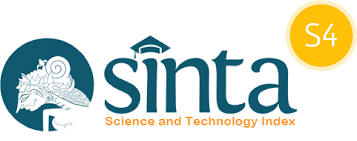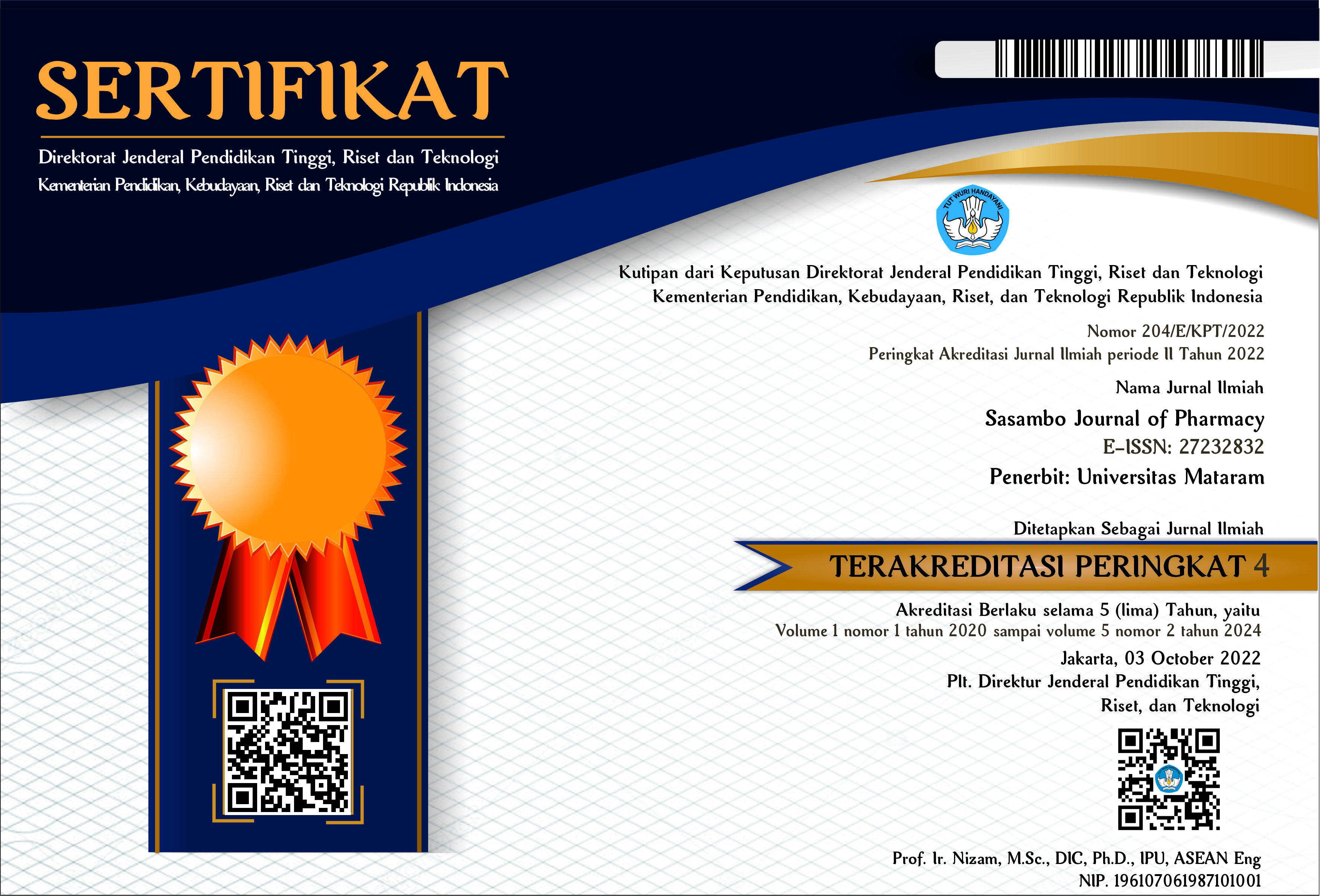Optimasi formula sampo ekstrak daun pacar air (Impatiens balsamina L.) dengan kombinasi natrium lauril sulfat dan cocamide DEA
DOI:
10.29303/sjp.v2i1.72Downloads
Abstract
Dandruff is an anomalous condition characterized by excessive exfoliation of the horny layer from the scalp. The leaves of the water henna plant (Impatiens balsamina L.) are one of the natural ingredients that have anti-dandruff properties, so they can be used as an active ingredient in making dandruff shampoo. The water henna leaves were extracted using the maceration method with ethanol 96%. Apart from the active ingredients, shampoo also has an important component, namely surfactants. The surfactant used in this study was a combination of sodium lauryl sulfate and cocamide DEA. The purpose of this study was to optimize the surfactant formula of sodium lauryl sulfate and cocamide DEA in water henna leaf extract shampoo. This research was a laboratory experimental research. Formula optimization was done through the Simplex Latice Design (SLD) method approach by making eight formulas. All formulas were evaluated for their physical properties including the foam height test and pH test. The data obtained were processed with Design Expert® software. Based on the physical evaluation of the water henna leaf extract shampoo, the results of the high foam test were 10,025 cm and a pH of 6,12. The results of the acceptability test of shampoo preparations including the parameters of color, smell, texture and viscosity received a fairly good response with the acquisition of values 3,1, 3,3, 3,9 and 4 with information 1 (very dislike), 2 (dislike), 3 (quite like), 4 (like) and 5 (really like). The optimum formula for the shampoo consisting of 5% water henna leaf extract, 1,1863% sodium lauryl sulfate, 19,814% cocamide DEA, 3% CMC, 0,5% citric acid, 0,5% methyl paraben, 0,15% menthol and distilled water had physical properties that meet the requirements of a good shampoo preparation.
Keywords:
Water henna leaves, shampoo, Simplex Latice DesignReferences
Astuti, D.P., Patihul, H., dan Kusdi, H., 2017. Formulasi dan uji stabilitas fisik sediaan gel antiseptik tangan minyak atsiri bunga lavender (Lavandula angustifolia Miller). Jurnal Farmaka Suplemen, 15(1), 176-84. Retrieved from http://jurnal.unpad.ac.id/farmaka/article/view/13252/pdf
Balai Besar Litbang Tanaman Obat dan Obat Tradisional. (2001). Pedoman Umum Panen dan Pascapanen Tanaman Obat. Tawangmangu: Balai Besar Litbang Tanaman Obat dan Obat Tradisional.
Doughari JH. (2006). Antimicrobial Activity of Tamarindus indica Linn. Tropical J Pharmaceu Res, 5(2), 597-603. Retrieved from https://www.researchgate.net/publication/43561012_Antimicrobial_Activity_of_Tamarindus_indica_Linn/link/55b64a9908ae9289a08aba19/download
Emmawati, T., Sidharta B., Puspita, O.E., & Syafitri, M. H. (2016). Optimasi Formula dan Teknik Pembuatan Sampo Susu Sapi Segar Menggunakan Kombinasi Surfactant dan Co- Surfactant. Majalah Kesehatan FKUB, 3(2), 93-111. Retrieved from https://majalahfk.ub.ac.id/index.php/mkfkub/article/view/95/88
Faizatun, Kartiningsih, & Liliyana. (2008). Formulasi Sediaan Sampo Ekstrak Bunga Chamomile dengan Hidroksi Propil Metil Selulosa Sebagai Pengental. Jurnal Ilmu Kefarmasian Indonesia. 6(1) p.15–22. Retrieved from http://jifi.farmasi.univpancasila.ac.id/index.php/jifi/article/view/412/288
Indrawati, T., & Nelly W. (2011). Stabilitas Sabun Cair Wajah yang Mengandung Susu Kambing dengan Variasi Konsentrasi Kokamide DEA. Jurnal Ilmu Kefarmasian Indonesia, 9(1), 8-13. Retrieved from https://www.google.com/url?sa=t&rct=j&q=&esrc=s&source=web&cd=&cad=rja&uact=8&ved=2ahUKEwi8leOAtMLtAhU1meYKHf_mCgAQFjAAegQIBRAC&url=http%3A%2F%2Fjifi.farmasi.univpancasila.ac.id%2Findex.php%2Fjifi%2Farticle%2Fdownload%2F313%2F223&usg=AOvVaw1_71nTeRSHOxShgWYeMO7o
Iswanti, D.A. (2009). Uji Aktivitas Antibakteri Fraksi N-Heksan, Fraksi Etil Asetat, dan Fraksi Etanol 96% Daun Ekor Kucing (Acalypha Hispida Burm. F) Terhadap Bakteri Staphylococcus aureus ATCC 25923 Secara Dilusi. (Master thesis). Fakultas Farmasi Universitas Setia Budi, Surakata. Retrieved from https://ejournal.unsrat.ac.id/index.php/pharmacon/article/view/8859/8417
Maesaroh, Imas. (2016). Formulasi Sediaan Sampo Jelly Anti Ketombe dari Ekstrak Kangkung (Ipomoea aquatica Forssk.). Jurnal Ilmiah Kopertis Wilayah IV, 1(1), 81-87. Retrieved from https://www.google.com/url?sa=t&rct=j&q=&esrc=s&source=web&cd=&cad=rja&uact=8&ved=2ahUKEwi-y-Gl57rtAhXKdCsKHVbdCNgQFjAAegQIBBAC&url=http%3A%2F%2Fjurnal.unpad.ac.id%2Ffarmaka%2Farticle%2Fdownload%2F13317%2Fpdf&usg=AOvVaw3pkYDtb0cxRmSB0BMrtHg4
Mahataranti, N., Astuti I.Y., & Asriningdhiani, B., (2012). Formulasi Shampo Antiketombe Ekstrak Etanol Seledri (Apium Graveolens L.) dan Aktivitasnya Terhadap Jamur Pityrosporum ovale. Jurnal Pharmacy, 9(2), 128-138. Retrieved from http://jurnalnasional.ump.ac.id/index.php/PHARMACY/article/view/710
Malonda, T.C., Yamlean, P. V. Y.& Citraningtyas, G. (2017). Formulasi Sediaan Sampo Antiketombe Ekstrak Daun Pacar Air (Impatiens Balsamina L.) Dan Uji Aktivitasnya Terhadap Jamur Candida Albicans Atcc 10231 Secara In Vitro. PHARMACON Jurnal Ilmiah Farmasi – UNSRAT, 6(4), 97-109. Retrieved from https://ejournal.unsrat.ac.id/index.php/pharmacon/article/view/17725/17250
Marpaung, M.P., & Romelan. (2018). Analisis Jenis Dan Kadar Saponin Ekstrak Metanol Daun Kemangi (Ocimum basilicum L.) Dengan Menggunakan Metode Gravimetri. Jurnal Farmasi Lampung, 7(2), 81-86. Retrieved from http://jurnal.utb.ac.id/index.php/jfl/article/view/57
Naitullah, N., Faisal J., Frengki & Maryulia D. (2014). Pengaruh Pemberian Ekstrak Etanol Daun Pacar Air (Impaiens balsamina Linn) Terhadap Pertumbuhan Candida albicans Secara In Vitro. Jurnal Medika Veterinaria, 8(2), 125-127. Retrieved from https://www.google.com/url?sa=t&rct=j&q=&esrc=s&source=web&cd=&cad=rja&uact=8&ved=2ahUKEwjtxszM6LrtAhXXXisKHY_LBTEQFjAAegQIBBAC&url=http%3A%2F%2Fwww.jurnal.unsyiah.ac.id%2FJMV%2Farticle%2Fdownload%2F3351%2F3141&usg=AOvVaw2rkeLrndv5eBYg-nQnLO7t
Nurhikma, E., Dewi A., & Selfyana A.T. (2018). Formulasi Sampo Antiketombe Dari Ekstrak Kubis (Brassica oleracea Var. Capitata L.) Kombinasi Ekstrak Daun Pandan Wangi (Pandanus amaryllifolius Roxb). Jurnal Mandala Pharmacon Indonesia, 4(1), 61-67. Retrieved from https://jurnal-pharmaconmw.com/jmpi/index.php/jmpi/article/view/25
Ramadhani, R.A. (2017). Review Pemanfaatan Design Expert Untuk Optimasi Komposisi Campuran Minyak Nabati Sebagai Bahan Baku Sintesis Biodiesel. Jurnal Teknik Kimia Dan Lingkungan, 1(1) 11-16. Retrieved from http://jtkl.polinema.ac.id/index.php/jtkl/article/view/5
Robinson, T. (1995). Kandungan Organik Tumbuhan Tinggi (Edisi ke-6). (Terjemahan oleh Kokasih Padmawinata). Bandung: ITB
Rowe, R.C., Sheskey P.J., & Quinn M.E. (2009). Handbook of Pharmacuetical Exipients (Sixth Edition). USA: Pharmaceutical Press.
Schramm LL. (2005). Emulsions, Foams, and Suspensions: Fundamentals and Applications. Weinheim: WILEY-VCH Verlag GmbH & Co. KGaA.
Septiadi T., Priggenies D. & Radjasa O.K. (2013). Uji Fitokimia Dan Aktivitas Antijamur Ektrak Teripang Keling (Holoturia atra) Dari Pantai Bandengan Jepara Terhadap Jamur Candida albicans. Journal of Marine Research, 2(2), 76-84. Retrieved from https://ejournal3.undip.ac.id/index.php/jmr/article/view/2355
Simaremare, E.S. (2014). Skrining Fitokimia Ekstrak Etanol Daun Gatal (Laportea decumana (Roxb.) Wedd). PHARMACY, 11(1), 98-107. Retrieved from http://jurnalnasional.ump.ac.id/index.php/PHARMACY/article/view/855
Sitompul M. B., Yamlean P.V.Y., & Kojong N.S. (2016). Formulasi Dan Uji Aktivitas Sediaan Sampo Antiketombe Ekstrak Etanol Daun Alamanda (Allamanda Cathartica L.) Terhadap Pertumbuhan Jamur Candida Albicans Secara In Vitro. PHARMACON Jurnal Ilmiah Farmasi – UNSRAT, 5(3), 122-130. Retrieved from https://ejournal.unsrat.ac.id/index.php/pharmacon/article/view/12946
Sudewo, B. (2009). Buku Pintar Hidup Sehat Cara Mas Dewo. Jakarta: Argo Media Pustaka.
Suharmiati & Herti, M, (2003). Khasiat dan Manfaat Jati Belanda. Surabaya: Agromedia Pustaka.
Susanto, azhar. (2008). Sistem Informasi Manajemen. Bandung: Lingga Jaya.
Wilkinson, J. B. & Moore, R. J. (1982). Harry’s Cosmeticology (Seventh Edition). London: George Godwin.
License
Authors who publish with Sasambo Journal of Pharmacy (SJP), agree to the following terms:
- Authors retain copyright and grant the journal right of first publication with the work simultaneously licensed under a Lisensi Creative Commons Atribusi 4.0 Internasional. This license allows authors to use all articles, data sets, graphics and appendices in data mining applications, search engines, web sites, blogs, and other platforms by providing an appropriate reference. The journal allows the author(s) to hold the copyright without restrictions and will retain publishing rights without restrictions.
- Authors are able to enter into separate, additional contractual arrangements for the non-exclusive distribution of the journal's published version of the work (e.g., post it to an institutional repository or publish it in a book), with an acknowledgment of its initial publication in Sasambo Journal of Pharmacy
- Authors are permitted and encouraged to post their work online (e.g., in institutional repositories or on their website) prior to and during the submission process, as it can lead to productive exchanges, as well as earlier and greater citation of published work (See The Effect of Open Access).







